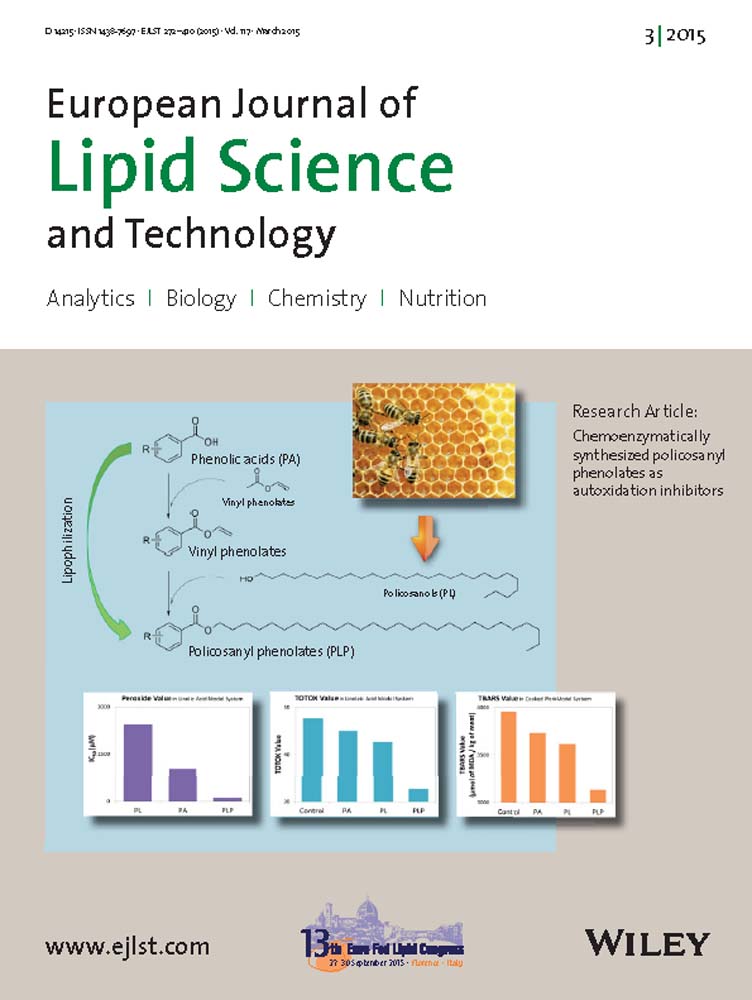View Item
- xmlui.general.dspace_homeCentros Regionales y EEAsCentro Regional Mendoza - San JuanEEA San JuanArtículos científicosxmlui.ArtifactBrowser.ItemViewer.trail
- DSpace Home
- Centros Regionales y EEAs
- Centro Regional Mendoza - San Juan
- EEA San Juan
- Artículos científicos
- View Item
Oil biogenesis and antioxidant compounds from “Arauco” olive (Olea europaea L.) cultivar during fruit development and ripening
Abstract
“Arauco” is the only olive (Olea europaea L.) cultivar recognized from Argentina in the World Catalogue of Olive Varieties. Drupes from this cultivar were handpicked at different stages of fruit development and ripening—referred to as days after full flowering (DAFF)—and analyzed to assess the oil accumulation pattern, and the dynamic of the changes in fatty acid, tocopherol, squalene, and phenolic compositions. The most intense oil accumulation period
[ver mas...]
“Arauco” is the only olive (Olea europaea L.) cultivar recognized from Argentina in the World Catalogue of Olive Varieties. Drupes from this cultivar were handpicked at different stages of fruit development and ripening—referred to as days after full flowering (DAFF)—and analyzed to assess the oil accumulation pattern, and the dynamic of the changes in fatty acid, tocopherol, squalene, and phenolic compositions. The most intense oil accumulation period occurred approximately between 80 DAFF (pit hardening) and 150 DAFF (beginning of fruit maturation). Oleic acid content increased rapidly until reaching the maximum concentration (71.4%) approximately 80 DAFF, thus indicating that the most active biosynthesis period occurred at early fruit growth stages. Later, oleic acid content decreased gradually, almost linearly, to 62% at the final sampling point (215 DAFF). The dynamic of tocopherol accumulation showed a trend characterized by high amounts of the α‐ and γ‐isoforms in very young drupes, a pronounced decrease during fruit development, and little or no change during the fruit maturation period. The developing drupes were found to accumulate significant amounts of squalene (up to 12 500 mg/kg of dry weight at 96 DAFF), but squalene dropped strongly after the beginning of fruit ripening. Whatever the stage of fruit development, secoiridoids were the major phenolic components. On the basis of the evolution of the analytical parameters studied, the best stage for processing “Arauco” fruits for oil production seems to be that where maturity index is higher than 1 and lower than 2.
[Cerrar]

Author
Bodoira, Romina Mariana;
Torres, Myriam Mariela;
Pierantozzi, Pierluigi;
Taticchi, Agnese;
Servili, Maurizio;
Maestri, Damian;
Fuente
European Journal Of Lipid Science And Technology 117 (3) : 377-388 (March 2015)
Date
2015-03
Editorial
Wiley
ISSN
1438-7697
1438-9312
1438-9312
Formato
pdf
Tipo de documento
artículo
Palabras Claves
Derechos de acceso
Restringido
 Excepto donde se diga explicitamente, este item se publica bajo la siguiente descripción: Creative Commons Attribution-NonCommercial-ShareAlike 2.5 Unported (CC BY-NC-SA 2.5)
Excepto donde se diga explicitamente, este item se publica bajo la siguiente descripción: Creative Commons Attribution-NonCommercial-ShareAlike 2.5 Unported (CC BY-NC-SA 2.5)

